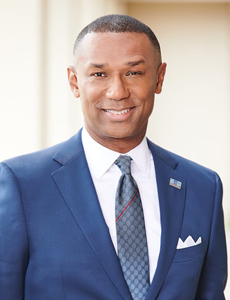At RISKWORLD 2023: SHRM’s CEO Johnny C. Taylor Urged Attendees to Own Their Organizational Culture

“People in so many ways are your biggest risk,” Johnny C. Taylor, president and CEO of the Society for Human Resource Management said, as he began his opening keynote presentation on May 1 at this year’s RISKWORLD in Atlanta.
Although no one can predict the talent-related risks that are soon to come, Taylor walked conference attendees through what his organization has deduced about the future of talent.
He began the presentation by reminding the risk management community of perhaps the scariest Friday the 13th they have ever experienced: Friday, March 13, 2020. The day the world shut down due the spread of COVID-19.
Who could have foretold the ways work would change after some companies told their staff to stay home for 14 days, then 21, then 90 days? Taylor began writing a book at that time to chronicle the ways work was changing during “The Great Pause” — a title he tentatively gave to his work.
But what he realized months in, was that we weren’t experiencing a pause; in fact, many sectors kept working during the height of the pandemic. What we were experiencing was a “great reset,” Taylor said.
Low-Wage Jobs Are Now Middle Class Jobs
The number one talent issue that has emerged as a result of the societal and economic reset the world experienced is wage inflation, Taylor said. “Low-wage jobs are becoming middle class jobs,” he said, which means it’s more expensive to do business.
To illustrate how we got to this place, Taylor took attendees back to those early days of the pandemic when many workers received emergency unemployment benefits that, on average, amounted to $25 per hour, according to a SHRM analysis. This made it difficult for many workers to rush when they were called back to jobs where they were making somewhere between $7.50 and $15 an hour, in the case of minimum wage positions.
The only way some employers have been able to fill vacant entry-level and low-wage positions has been to pay them much higher wages. And this is how we have arrived at low-wage jobs having turned into middle class jobs: “People are getting $25 to run a cash register,” Taylor shared as an example.
And though people are technically getting paid more, labor participation is going down, Taylor pointed out. Much has been reported on women leaving the workforce during the height of the pandemic, but many of them have gone back to work. One perhaps less reported statistic, he said, is that seven million men between the ages of 25-44 have left the workforce.
Additionally, worker productivity, he said, is falling at the fastest rate in four decades. “This is a perfect storm that we are all facing,” he added.
How to Continue Waging the War for Talent
So, how can employers continue competing in the war for talent?
Taylor said SHRM has conducted extensive outreach to capture what it is that new recruits and current employees want. First and foremost, people want flexibility in their work — not just remote work. Both the newest entrants and seasoned employees want the benefit of human interaction that they can get from the workplace, Taylor noted.
Although many employers still strive to emulate the culture of many larger employers well-known for their elaborate snack bars, relaxation rooms and other niche amenities, Taylor said perks are passé; employees are more concerned with having better compensation: “Give me the money and I’ll figure my life out,” in other words.
Much has been said about The Great Resignation, but Taylor said now we’re seeing The Great Regret. “Boomerang is a real thing,” he said, and 80% of employees regret having jumped ship for shiny new offers. Employers have to be willing to let employees who previously brought value to their organizations return if the place where they landed after jumping ship is not what they thought it would be.
And in some cases, Taylor suggested even checking in with former valued employees 30, 60 and 90 days after they leave, just to gauge the chance of them returning.
Like employers, workers are also paying close attention to the economy and recognize that job security is a thing of the past, Taylor shared. And as such, many people are more focused instead on career development. Knowing that their specific roles and responsibilities could be terminated at any time, Taylor said employees are looking for employers to prepare them for their next jobs. “Even the best employees expect you to invest in them,” he said, and they know professional development should be part of their package.
But don’t be discouraged if employees leave even after you’ve paid more than $100,000 for them to get an MBA, he shared as a personal example he recently experienced. The cold reality, he said, is that loyalty is out.
Let’s Figure Out How to Work Together
Lastly, Taylor discussed the emphasis organizations have placed since 2020 on what he called “overly-prescribed” policies and programs aimed at diversity recruitment and marketing. Workers today want culturally-embedded IE&D — inclusion, equity and diversity.
“Let’s figure out how to get us all to work together,” he said.
It’s not enough for an organization to have a staff member whose job it is to recruit diverse talent; that should be part of every recruiters job by now, he said. Nor is it enough for an organization to tout its contributions to social causes and organizations. All of this has to be embedded into the way it operates and has to be used to help mitigate against the siloes that are strengthening in our society today, he shared.
And in today’s political climate where even college students are reluctant to live in the same dorms with other students who do not share their perspective on politics and social issues, he said, this is no easy task.
“People believe in diversity as long as they agree with it,” he said.
In his concluding comments, he also encouraged the audience to place a greater emphasis on how they weave caring for the mental health of their staff into their organizational culture. While it’s commonplace for organizations to invest extensive resources into benefits aligned with physical health, “there’s no parity in how we deal with mental health,” he said.
Get Two Things Right, and You’re 90% There
Having compiled his chronicles of the last several years’ major shifts in the workplace into his book, “RESET: A Leader’s Guide to Work in an Age of Upheaval,” Taylor offered two final pieces of advice to attendees looking to bolster their resilience when it comes to navigating talent risks:
“Be clear about what it means to work at your shop and then people can decide if they want to work there or not,” he said. “Stop hiring just for technical competency, he said; [staff] must be culturally aligned. This sentiment could raise an eyebrow, he noted, but if an organization clearly communicates with new hires what its cultural values are and then lives up to those values, it can have a better chance at finding alignment with its workforce.
Focusing on these two points could also help organizations striving to engage their workers and ward off “quiet quitting,” and what Taylor said is the bigger issue at play today, “resentee-ism” where employees are productive but resent their employers.
“If you get these two things right,” Taylor said, “you’re 90% there.” &











